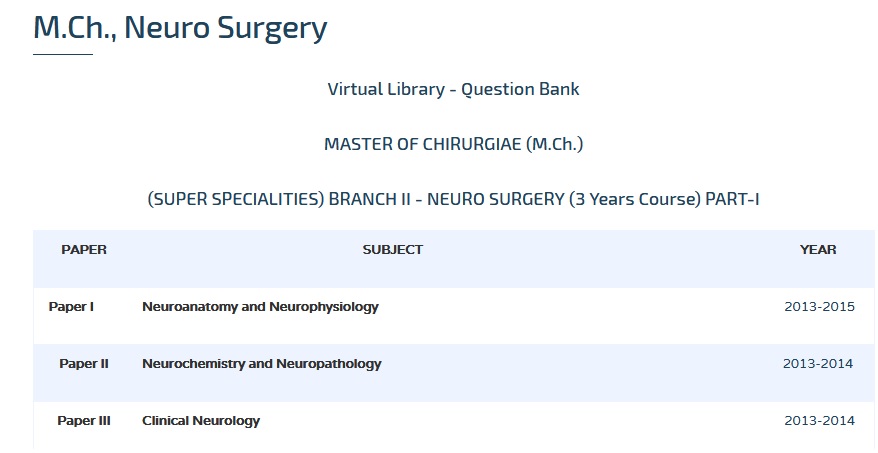Operative Neuro Surgery & Recent Advances M.Ch Question Bank : web.tnmgrmu.ac.in
Name of the University : The Tamilnadu Dr. M.G.R. Medical University
Degree : MASTER OF CHIRURGIAE (M.Ch.)
Branch : BRANCH II – NEURO SURGERY
Subject Code/Name : 1572/Operative Neuro Surgery And Recent Advances
Paper : II
Document Type : Question Bank
Website : web.tnmgrmu.ac.in
Download Model/Sample Question Paper :
(5 Years Course) :
Candidates admitted upto 2004-05 :
Part III :
1990-2000 : https://www.pdfquestion.in/uploads/web.tnmgrmu.ac.in/4551-1-181572KC.pdf
2001-2014 : https://www.pdfquestion.in/uploads/web.tnmgrmu.ac.in/4551-2-181572KU.pdf
TNMGRMU Operative Neuro Surgery Question Paper
Sub. Code: 1572
MASTER OF CHIRUGIAE (M.Ch.) DEGREE EXAMINATIONS
(Higher Specialities)
(New and Revised Regulations for 5 years course)
Branch II – Neuro Surgery
PART – III
Paper II – OPERATIVE NEURO SURGERY AND RECENT ADVANCES
Q.P. Code: 181572
Time: Three hours
Maximum: 100 Marks
Related : TNMGRMU Basic Sciences & General Principles in Plastic Surgery M.Ch Question Bank : www.pdfquestion.in/4552.html
February 2009
Answer ALL questions :
Draw suitable diagrams wherever necessary. :
I. Essays: (2 x 20 = 40)
1. Enumerate the Etiology of cranial defects, Indications, techniques and results of cranioplasties.
2. Describe the recent advances in the management of Neurotrauma.

II. Write short notes on: (10 x 6 = 60)
1. Briefly describe neurogenic bladder and its management.
2. Describe myelomeningocele, its management and outcome.
3. Arachnoid cysts and their surgical options.
4. Describe the spontaneous regression of syringomyelia, review the current etiological theories and their implications for surgery.
5. Role of blood brain barrier in CNS infections.
6. Describe brain oedema and its management.
7. Describe the pathophysiology, diagnosis and treatment of Neurogenic claudication.
8. Parinaud syndrome.
9. Describe the surgical management of traumatic intracranial haematomas.
10. Describe the destructive procedures for the treatment of non malignant pain and review the literature.
August 2009
I. Essays: (2 x 20 = 40)
1. Describe the etiology, pathogenesis, diagnostic evaluation and management options for lumbar canal stenosis.
2. Recent advances in the diagnosis and treatment of central nervous system germ cell tumours.
II. Write short notes on: (10 x 6 = 60)
1. Describe briefly the cranial nerve injuries associated with basilar skull fractures.
2. Tarsal tunnel syndrome.
3. Describe minimally invasive procedures for the treatment of failed back surgery syndrome.
4. Cryoneurolysis.
5. Describe the practical utility of immunohistochemical markers in brain tumour diagnosis and prognosis.
6. Describe percutaneous vertebral augmentation and its application in neurosurgical practice.
7. Describe the neurobiology of the epileptogenesis in the temporal lobe.
8. C.T. guided fluoroscopy.
9. Role of brain and brainstem implant technology in the treatment of neurosurgical disorders.
10. Describe briefly the indications, advantages, disadvantages and complications of intrathecal medications.
August 2011
I. Elaborate on :
1. Discuss the various surgical approaches to the lesions in the third ventricle.
2. Discuss the clinical presentation and management of Anterior circulation aneurysms.
II. Write notes on :
1. Diffusion tensor imaging.
2. Neural prosthesis.
3. Minimally invasive procedures for intractable trigeminal Neuralgia.
4. Endoscopic third ventriculostomy.
5. Surgical approaches to petroclival meningiomas.
6. Posterior dynamic stabilization for lumbar spine.
7. Surgery for intracranial arachnoid cysts.
8. Radiosurgery.
9. Carotid endarterectomy.
10. Cervical disc replacement.
August 2012
I. Elaborate on:
1. Discuss the clinical features of Posterior IIIrd Ventricular lesions, investigations and various Surgical management of the same.
2. Describe briefly the history, technique, principles and applications of Sterotaxy in Modern Neurosurgery.
II. Write notes on:
1. Basics and applications of Magnetic Resonance Tractography.
2. Discuss about Neural Prosthesis.
3. Write briefly about Endoscopic Assisted Neurosurgical Procedures.
4. Discuss carotid endarterectomy after Acute Ischemic Stroke.
5. Clinical and ethical issues of Brain death.
6. Various cranioplasty methods – Discuss.
7. Clinical features and management of Hyponateremia.
8. Discuss the Adjuvant therapy for gliomas.
9. Management of Hypertensive ICH.
10. Discuss the uses of Radiosurgery.
August 2013
Sub. Code: 1572
I. Elaborate on: (2X15=30)
1. Discuss the operative approaches for the management of a suprasellar craniopharyngioma with multiple cysts and hydrocephalus.
2. Discuss the differential diagnosis in a five year old child with an enhancing lesion in the right temporal lobe presenting with recurrent seizures for one year. Outline the presurgical evaluation and management in this patient.
II. Write notes on: (10X7=70)
1. Hemostatic agents in neurosurgery.
2. Intraoperative ultrasound in neurosurgery.
3. Somatosensory evoked potential.
4. Rotary atlanto axial dislocation.
5. Endoscopic anatomy of sphenoid sinus and sella.
6. Management of a 1.5cm vestibular schwannoma in a 30 year old female.
7. Intraventricular cysticercal cyst.
8. Lumbar dermal sinus in a two year old child.
9. Complications of ventriculoperitoneal shunt.
10. Prolactinoma.
February 2014
Sub. Code: 1572
M.Ch. – NEURO SURGERY
I. Elaborate on: (2X15=30)
1. Discuss the various approaches for management of tuberculous spondylitis at C1-2 level in a twenty year old male with neck pain and minimal neurological deficits with no functional impairment.
2. Discuss the management options in a twenty five year old male with an insular glioma who presented with one episode of complex partial seizure.
II. Write notes on: (10X7=70)
1. Frontal sinus mucocoele.
2. Motor evoked potential.
3. Lumbosacral lipomyelomeningocoele.
4. Growing skull fracture.
5. Complications of endoscopic third ventriculostomy.
6. Giant cavernous carotid aneurysm.
7. Subdural empyema.
8. Vertebral haemangioma.
9. Compound depressed fracture of parietal bone.
10. Acromegaly.